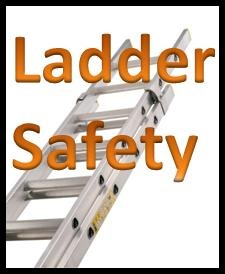How To Improve Ladder Safety
Keeping Things Safe On the Ladder
Spring means many homeowners will be outside working in the yard, pruning trees and cleaning gutters. This article covers how to improve ladder safety.
Each year in the U.S., accidents involving ladders cause more than 300 deaths and 160,000 injuries requiring emergency medical attention. Ladder accidents usually are caused by improper selection, care or use and not by manufacturing defects.
Common Ladder Hazards
Some of the more common hazards involving ladders, such as instability, electrical shock, and falls, can be predicted and prevented.
Prevention requires proper planning, correct ladder selection, good work procedures and adequate ladder maintenance.
Here’s a few tips on extension ladder safety:
- Prior to setting up a ladder inspect the ladder for loose or missing parts, cracks, rivets, joints nuts, rung locks, and bolts and damage.
- Prior to setting up a ladder check overhead for electrical wire4s and obstructions
- Inspect the base the ladder will be placed on. Be aware of slippery conditions or slopes.
- The distance from the base of the house to the base of the ladder should be 1/4 the height of the ladder. Approximately 75 degrees.
- It is extremely important to make sure the ladder’s foot pads are secure on a firm, level surface. Shim if necessary.
- If you are on grass I recommend tilting the foot pads and sink the ladder into the ground a bit by stepping / hopping on the first step and using your weight to set the ladder.
- If the ladder is resting on a top support point the ladder MUST extend 3-feet above the roof point if the climbers intent is to mount the roof.
- Do not place a ladder near a door without locking and labeling the door that a ladder and hazard is present.
- Keep ladders away from electrical lines and pay attention to overhead lines when moving the ladder from one location to another or into into position.
- Never attempt to stretch while on a ladder, set the ladder up in the middle of where you would like to work. If you can’t reach, move the ladder.
- Only one person on a ladder at a time.
- As a general rule, never step on the top three rungs of an extension ladder.
- Consider the weight place on the ladder which includes the operator, tools and any materials used or stored on the ladder. See ladder types below.
- Us a stabilizer to support the upper section of the ladder and tie of whenever possible.
- For maximum safety have someone hold the ladder.
- Wear slip resistant sole shoes with adequate sole padding to prevent foot fatigue.
- Protect, clean and store ladders. Protect from heat, weather and corrosive materials.
- Read warning and instruction labels on the ladder.
Proper Use
- Continually face the ladder as you climb, work or descend the ladder
- Always maintain three points of contact with the ladder when climbing.
- Keep hands free when climbing.
- Keep the middle of your body within the middle section of the side rails ./ do not overreach.
- Overreaching is one of the most common causes of ladder accidents.
- If climbing onto a roof, step sideways.
Improper Use
Common factors contributing to falls from improper ladders use include:
- Haste
- Sudden movement
- Poor quality footwear
- Lack of attention
Ladder Selection
Portable ladders are designed as “one-man” equipment with the proper strength to support the worker as well as his tools and materials.
Consider the work site environment when choosing your ladder and type of ladder such as using fiberglass ladders near electrical sources.
Ladders are constructed under three general classes:
Type IA Industrial
Heavy-duty with a load capacity not more than 300 pounds.
Type I Industrial
Heavy-duty with a load capacity not more than 250 pounds.
Type II Commercial
Medium-duty with a load capacity not more than 225 pounds (suited for painting and similar tasks).
Type III Household
Light-duty with a load capacity of 200 pounds.
Stay safe ~ concord carpenter











